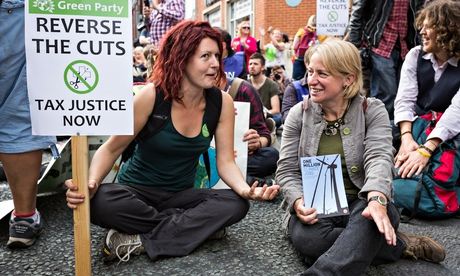
Support for the Greens has surged in recent weeks, with a number of polls placing them on 10% or more of the vote, ahead of the Liberal Democrats. This has generated a lot of concern among Labour commentators, who worry that rising Green support will split the left-leaning vote and further complicate a path to victory already made more tortuous by the SNP surge in Scotland and the Ukip surge in traditional working-class seats.
There are good reasons to worry: the Greens draw their strength primarily from younger, socially liberal and economically leftwing university graduates, a group who do indeed tilt heavily towards Labour at present.
The direct threat from the Greens is limited – the party is still relatively weak, and has little organisation or electoral track record outside of a handful of established strongholds such as Brighton and Norwich.
There is little chance of a direct Green challenge in more than a handful of seats, even if the current support level is maintained or increased. The larger threat to Labour comes from the indirect effects of a Green surge, particularly in key target seats where the party can ill afford to leak support.
Where is the Green threat to Labour most potent? In the table we outline 22 key Labour battlegrounds (including a few seats the party already holds) where the potential for red to green defection is highest. We calculate this potential using the national Mosaic dataset, which classifies small areas into different categories based on their social and economic composition, and local election results in 2012 and 2014.
We identify a set of social groups who have shown a willingness to vote for both Labour and for the Greens in post-2010 local elections, and then tabulate the marginal seats with the largest concentrations of these groups.
Several different groups of seats emerge. The first is a cluster of Liberal Democrat-held urban battlegrounds – seats the party often won from Labour in 2005, riding a wave of liberal-left anger about student fees and the Iraq war.
These seats, such as Manchester Withington, Bristol West, Cardiff Central and Hornsey and Wood Green, are central to Labour’s election strategy. These are the seats where there was a mass exodus of left-liberal Lib Dem voters to Labour after the 2010 formation of the coalition government.
Labour have performed strongly in such seats in local elections and constituency polling by Lord Ashcroft, and until recently considered many to be very strong pick-up opportunities. The rise of the Greens puts them back at risk, as the disaffected and often idealistic voters Labour had won back may now see the Greens as a more potent outlet for their disaffection than Labour, as well as a closer fit with their social values. Labour often requires a large swing to overcome well entrenched and well organised Lib Dem incumbents, so even a relatively modest leakage to the Greens could make life difficult.
There are also a number of more traditional Labour-Conservative battlegrounds with large pools of potential Green sympathisers, particularly in the wealthier parts of London and along the south coast, including Battersea, Hendon, Brighton Kemptown and Hove. In many of these seats, a mixed-income socially liberal Labour vote faces off against a solid high-income Conservative vote, which may be bolstered by rapid gentrification and soaring property prices.
Any leakage of Labour votes to the Greens will make it easier for the Conservatives to hold on against the tide. There are also a few Labour-held marginals in the capital where the Greens could cause real headaches – most notably Tooting, whose MP Sadiq Khan heads Labour’s green taskforce, and who has the second largest concentration of potential Green defectors in his own backyard.
There are also a number of three–corner fights in our list, seats such as Watford, Hampstead and Kilburn, and Cambridge and Norwich South, where a surge in the Greens further complicates election campaigns in seats where the vote is already closely divided among all three parties.
The risk in these seats is twofold – firstly, already complex contests become extremely unpredictable and hard to manage with votes flowing in multiple directions across four contenders.
Secondly, the Conservatives may win or retain such seats even on a reduced share of the vote simply because their vote unifies the local rightwing electorate, with the different tribes of left support splintered across three different challengers.
The Greens thus have the potential to cause problems for Labour in a variety of different ways. However, they may not be able to realise this potential across the board. Past Green strength has been highly concentrated in a small number of local strongholds, such as Brighton, Norwich and Oxford. They have little time to build the organisations needed to harness their buoyant poll rating and mobilise support, and it is unlikely they will have the resources needed to do so in all of the seats we identify.
The strongest challenges are likely to come in areas where the Greens are already established, such as the key Conservative-held marginals Hove and Brighton Kemptown, which neighbour the Green party’s only current seat, and the Lib Dems’ Norwich South, where the party secured 15% last time. While Green surges may not appear in all of the seats on our list, these are the seats where the ground is most fertile, and Labour have most cause to worry.
How could Labour combat this latest challenge? The voters fuelling the Green boom share one characteristic with supporters of the more established Ukip and SNP insurgencies – a deep-seated disaffection from all those associated with the political establishment. Finding a way to address this entrenched distrust will be essential if Labour is to retain or win back these voters. Retail political messages or “don’t let the Tories in” appeals are unlikely to work with voters who have lost faith entirely in politics as usual.
Besides the general problem of disaffection, Labour also face a specific problem with the Greens, who mobilise a distinct set of values into political competition. The Greens – young, highly educated, cosmopolitan liberal idealists – are more or less the polar opposite to Ukip’s ageing, socially conservative, nationalist electorate. Labour is losing votes to both, but any policy which appeals to voters at one pole will anger those at the other. This leaves the party with a deep dilemma on substantive issues such as immigration, and symbolic issues such as national identity. Taking any firm position will anger one of these groups, but taking no firm position risks angering both.
It is not clear yet whether the Greens’ polling surge will last, or whether the party will be capable of turning its new popularity into votes. Yet this latest sudden shift in the ever less predictable British political weather once again demonstrates that the old model of political competition is rapidly becoming obsolete. Whatever the outcome in 2015, the disaffected, idealistic young graduates currently mulling a Green vote will be restlessly looking for change, and will continue to pose questions for Labour well after 7 May 2015
Robert Ford is senior lecturer in politics at the University of Manchester


